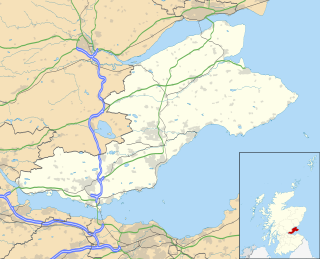
Fife is a council area, historic county, registration county and lieutenancy area of Scotland. It is situated between the Firth of Tay and the Firth of Forth, with inland boundaries with Perth and Kinross and Clackmannanshire. By custom it is widely held to have been one of the major Pictish kingdoms, known as Fib, and is still commonly known as the Kingdom of Fife within Scotland. A person from Fife is known as a Fifer. In older documents the county was very occasionally known by the anglicisation Fifeshire.

Dunbeath Castle is located on the east coast of Caithness, 2 kilometres (1.2 mi) south of Dunbeath, in northern Scotland. Although a castle has stood here since the 15th century, the present building is of mainly 17th-century origin, with 19th-century extensions. The castle is a 19,669 sq ft (1,827.3 m2) Category A listed building and the grounds are included in the Inventory of Gardens and Designed Landscapes in Scotland.

Pittenweem ( ) is a fishing village and civil parish in Fife, on the east coast of Scotland. At the 2001 census, it had a population of 1,747.

Pittenweem Priory was an Augustinian priory located in the village of Pittenweem, Fife, Scotland.

The East Neuk or East Neuk of Fife is an area of the coast of Fife, Scotland.
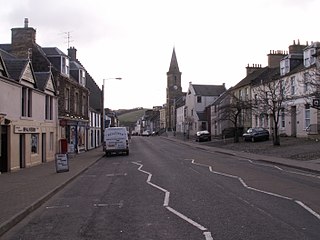
Newburgh is a royal burgh and parish in Fife, Scotland, at the south shore of the Firth of Tay. The town has a population of 2,171, which constitutes a 10% increase since 1901 when the population was counted at 1,904 persons.

St Monans, sometimes spelt St Monance, is a village and parish in the East Neuk of Fife and is named after the legendary Saint Monan.

Duns Castle, Duns, Berwickshire is a historic house in Scotland, the oldest part of which, the massive Norman Keep or Pele Tower, supposedly dates from 1320. The castle and most of the structures on the property are designated as a scheduled ancient monument.
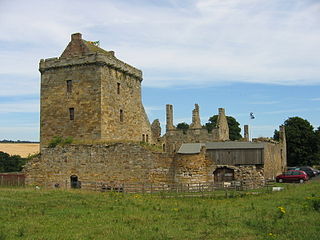
Balgonie Castle is located on the south bank of the River Leven near Milton of Balgonie, 3.5 kilometres (2.2 mi) east of Glenrothes, Fife, Scotland. The castle keep dates from the 14th century, and the remaining structures were added piecemeal until the 18th century. The keep has been recently restored, although other parts of the castle are roofless ruins. Balgonie, excepting the tower which is used for residential purposes, is a Scheduled Ancient Monument. This castle is the subject for several ghostlore stories, including a green lady story.
Abercrombie is a village in Fife, Scotland.

The Fife Coastal Path is a Scottish long distance footpath that runs from Kincardine to Newburgh along the coastline of Fife. The path was created in 2002, originally running from North Queensferry to Tayport. It was extended in 2011 with a new section running from Kincardine to North Queensferry, then again in 2012 from Tayport to Newburgh. The path, which usually takes between one week and 10 days to walk in full, now runs for 187 kilometres (116 mi). The Fife Coastal Path is managed and maintained by Fife Coast and Countryside Trust, a registered environmental charity, and is designated as one of Scotland's Great Trails by NatureScot. About 500,000 people use the path every year, of whom about 35,000 walk the entire route.

Cambo Estate lies close to the village of Kingsbarns in north-east Fife, Scotland. It is within the East Neuk, 10 kilometres (6.2 mi) south-east of St Andrews. At the heart of the estate lies the 19th-century Cambo House, the home of Sir Peter Erskine, Bt and Lady Catherine Erskine. The gardens of Cambo are open to the public, and include the walled garden and seasonal snowdrop gardens. Elsewhere on the estate is the Kingsbarns Golf Links golf course, which co-hosts the Alfred Dunhill Links Championship every year.
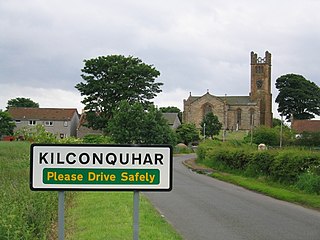
Kilconquhar is a village and parish in Fife in Scotland. It includes the small hamlet of Barnyards. It is bounded by the parishes of Elie, Ceres, Cameron, St Monans, Carnbee, Newburn and Largo. It is approximately 9 miles from north to south. Much of the land is agricultural or wooded. The village itself is situated inland, north of Kilconquhar Loch. Also in the civil parish are Colinsburgh and Largoward, the latter since 1860 being a separate ecclesiastical parish.

Rosyth Castle is a fifteenth-century ruined tower house on the perimeter of Rosyth Naval Dockyard, Fife, Scotland.

MacDuff's Castle is a ruined castle near East Wemyss, in Fife, Scotland. The site is associated with the MacDuff Earls of Fife, the most powerful family in Fife in the Middle Ages, although nothing survives from this period. The present ruins are the remains of the home of the Wemyss family, who lived here from the 14th century, and their successors in the 16th century.
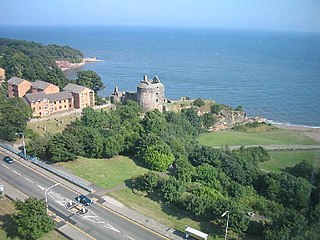
Ravenscraig Castle is a ruined castle located in Kirkcaldy which dates from around 1460. The castle is an early example of artillery defence in Scotland.

Murthly is a village in Perth and Kinross, Scotland. It lies on the south bank of the River Tay, 5 miles southeast of Dunkeld, and 9+1⁄2 miles north of Perth. Perth District Asylum, later known as Murthly Hospital, was opened in the village on 1 April 1864 for 'pauper lunatics'. It was the second district asylum to be built in Scotland under the terms of the Lunacy (Scotland) Act 1857. It closed in 1984 and was later demolished. The village has a stone circle, in the former grounds of the hospital. The village formerly had a railway station on the Perth and Dunkeld Railway, which closed in 1965.
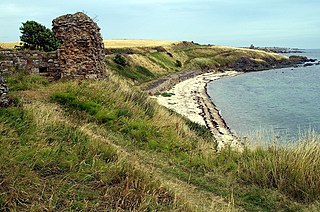
Ardross Castle was a c.14th century castle that was located in Elie and Earlsferry, Fife, Scotland, near the sea.

Elie House is a country house in Elie, Fife, Scotland. It is a Category A listed building.


















